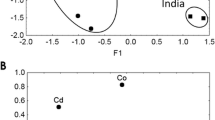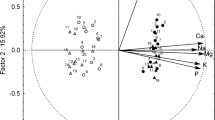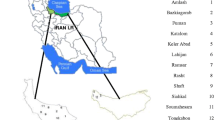Abstract
The metal contents of eleven black tea samples, four cultivated in Iran and seven imported, and their tea infusions were determined. Twelve elements consisting toxic metals (Al, As, Pb, Cr, Cd, and Ni) and essential mineral elements (Fe, Zn, Cu, Mn, Ca, and Mg) were analyzed using inductively coupled plasma atomic emission spectroscopy (ICP-AES). Al, Ca, Mg, and Mn ranged in black tea leaves at mg g−1 levels, while Cr, Fe, Ni, Cu, Zn were at µg g−1 levels. Analysis of variance showed no statistically significant differences among most elements determined in cultivated and imported black teas in Iran except for Ni and Cu. The extraction efficiency of each element into tea infusions was evaluated. The solubility of measured metals in infusion extracts varied widely and ranged from 0 to 59.3%. Among the studied elements, Cr, Pb, and Cd showed the lowest rates of solubility and Ni had the highest rates of solubility. The amount of toxic metals and essential mineral elements that one may take up through consumption of black tea infusion was estimated. The amount of realizing each element into tea infusions and acceptable daily intake, for safety consumption of black tea, was compared.

Similar content being viewed by others
References
Dufresne CJ, Farnworth ER (2001) A review of latest research findings on the health promotion properties of tea. J Nutr Biochem 12:404–421
Weisburger JH (1997) Tea and health: a historical perspective. Cancer Lett 114:315–317
Luczaj W, Skrzydlewska E (2005) Anti-oxidative properties of black tea. Prev Med 40:910–918
Mark H (2007) The beneficial effects of tea on immune function and inflammation: a review of evidence from in vitro, animal, and human research. Nutr Res 27:373–379
Siddiqui IA, Raisuddin S, Shukla Y (2005) Protective effects of black tea extract on testosterone induced oxidative damage in prostate. Cancer Lett 227:125–132
Way T, Lee H, Kao M, Lin J (2004) Black tea polyphenol theaflavins inhibit aromatase activity and attenuate tamoxifen resistance in HER2/neu-transfected human breast cancer cells through tyrosine kinase suppression. Eur J Cancer 40:2165–2174
Record IR, Dreosti IE (1998) Protection by black tea and green tea against UVB and UVA + B induced skin cancer in hairless mice. Mutat Res 422:191–199
Fujita H, Yamagami T (2008) Antihypercholesterolemic effect of Chinese black tea extract in human subjects with borderline hypercholesterolemia. Nutr Res 28:450–456
Seenivasan S, Manikandan N, Muraleedharan NN, Selvasundaram R (2007) Heavy metal content of black teas from south India. Food Control 19:746–749
Fernandez PL, Pablos F, Martin MJ, Gonzalez AG (2002) Multi-element analysis of tea beverages by inductively coupled plasma atomic emission spectrometry. Food Chem 76:483–489
Matsuura H, Hokura A, Katsuki F, Itoh A, Haraguchi H (2001) Multi-element determination and speciation of major-to-trace elements in black tea leaves by ICP-AES and ICP-MS with the aid of size exclusion chromatography. Anal Sci 17:391–398
Feng H, Wang T, Yau SF (2003) Sensitive determination of trace-metal elements in tea with capillary electrophoresis by using chelating agent 4-(2-pyridylazo) resorcinol (PAR). Food Chem 81:607–611
Xie M, Vonbohlen A, Klocckenkamper R, Jian X, Guntherk K (1998) Multielement analysis of Chinese tea (Camellia sinensis) by total-reflection X-ray fluorescence. Eur Food Res 207:31–38
Long GL, Winefordner JD (1983) Limit of detection: a closer look at the IUPAC definition. Anal Chem 55:713A–724A
Cao X, Zhao G, Yin M, Li J (1998) Determination of ultra trace rare earth elements by inductively coupled plasma mass spectrometry with microwave digestion and AG50W-x8 cation exchange chromatography. Analyst 123:1115–1119
Zhang M, Fang L (2007) Tea plantation-induced activation of soil heavy metals. Comm Soil Sci Plant Anal 38:1467–1478
Özcan M (2005) Determination of mineral contents of Turkish herbal tea (Salvia aucheri var. canescens) at different infusion periods. J Med Food 8:110–112
Powell JJ, Burden TJ, Thompson RP (1998) In vitro mineral availability from digested tea: a rich dietary source of manganese. Analyst 123:1721–1724
Fernandez-Caceres P, Martin MJ, Pablos M, Gonzalez AG (2001) Differentation of tea (Camellia sinensis) varietes and their geographical origin according to their metal content. J Agric Food Chem 49:4775–4779
Costa LM, Gouveia ST, Nóbrega JA (2002) Comparison of heating extraction procedures for Al, Ca, Mg and Mn in tea samples. Anal Sci 18:313–318
Natesan S, Ranganathan V (1990) Content of various elements in different parts of the tea plant and in infusion of black tea from South India. J Agric Food Chem 51:125–139
Food and Nutrition Information Center, Dietary Guidance/Dietary Reference Intakes/DRI Tables, Dietary Reference Intakes: Elements, http://www.iom.edu/Object.File/Master/7/294/0.pdf
Author information
Authors and Affiliations
Corresponding author
Rights and permissions
About this article
Cite this article
Salahinejad, M., Aflaki, F. Toxic and Essential Mineral Elements Content of Black Tea Leaves and Their Tea Infusions Consumed in Iran. Biol Trace Elem Res 134, 109–117 (2010). https://doi.org/10.1007/s12011-009-8449-z
Received:
Accepted:
Published:
Issue Date:
DOI: https://doi.org/10.1007/s12011-009-8449-z




